Sabino Canyon is a popular tourist attraction and outdoor hotspot located in the Santa Catalina Mountains and is considered to be part of the Coronado National Forest in Tucson, AZ. Over the years, Sabino Canyon has grown to become one of the biggest recreation areas for people of the Tucson area. The canyon provides a diverse option of trails that are perfect for walking, hiking, and biking for all ages and levels of experience. The variety of trails gives visitors the opportunity to experience something new every time they enter the canyon. However, some things that will always remain the same are the natural beauty of the desert and the exciting chance to see some of the Sonoran Desert's favorite wild critters. This attraction has a rich history that has developed greatly overtime. Currently the canyon has over 1 million visitors per year and receives support from wonderful volunteers and the USDA Forest Service.
https://www.youtube.com/watch?v=iI53-aKqHjw
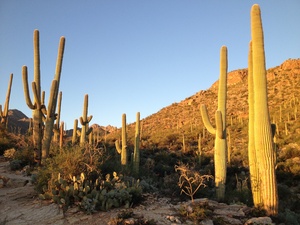 Photography by: Eric Landwher
Photography by: Eric Landwher 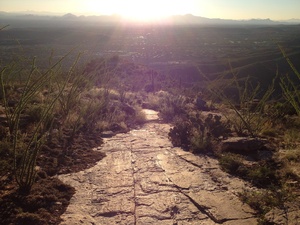 Photography by: Eric Landwher
Photography by: Eric Landwher
History
The natural outdoor attraction began over 12 million years ago with the formation of the Santa Catalina Mountain Range. In approximately 5 million B.C. the mountain formation concluded in the Tucson area and created the foundation for living organisms. Sabino Canyon was home to some of the earliest forms of life and it is predicted that the plant life began between 6,000-8,000 years ago. In addition to plants there is evidence that some of the earliest humans like, the Native American Hohokam people made lives for themselves in this region as they learned to adapt to the climate change. Many years later in 1887, an earthquake occurred in northern Mexico. This earthquake caused massive boulders along the canyon walls to tumble down and crash into the valley. The affect of this disaster was not repaired until 1905 when the Forest Service was first created. During the Great Depression the Works Progress Administration (WPA) and Civilian Conservation Corporation (CCC) constructed 9 bridges over Sabino Creek and created the Sabino Dam. The goal of these attractions were to make improvements in the Tucson area. Tucson citizens hoped that this would become a recreation center for boating, fishing, camping, and more. The CCC worked to build picnic tables, campgrounds, grills and other recreational benefits that are still used today. By 1940 the construction and road leading from the lower portion of the canyon to the top was completed, and by 1960 the Forest Service had expanded the road ever lower into Bear Canyon. Currently the road travels 4 miles up the canyon starting from the Visitor's Center. Even though the Sabino Dam is no longer used for fishing and can rarely be used for swimming it is still one of the most popular attractions inside the canyon. In addition to the Dam, all of the other hard work that the WPA and CCC put into the canyon is frequently being restored to make sure that visitors are given the opportunity to make the most out of their Sabino Canyon excursion.
 Photography by: Eric Landwher
Photography by: Eric Landwher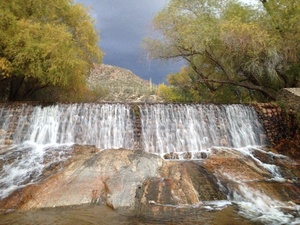 Sabino Dam Photography by: Eric Landwher
Sabino Dam Photography by: Eric Landwher
Visitor Center & Bookstore
The Sabino Canyon Visitor Center was officially established in June 1964. The Forest Service created the center in hopes to gain more attraction and to teach people the wonders of the canyon. The Visitor Center is conveniently located immediately north of the parking lot and it is encouraged that all new comers or even veterans stop in for new information on the canyon when visiting. Overtime the Visitor Center began to expand and eventually a hands-on exhibit was added that teaches people of all ages about Sabino Canyon's history, plants, and animals. The Visitor Center is open 8:00 a.m.to 4:30 p.m. seven days a week with an exception to several holidays. The center has a wonderful staff that is available to answer any questions one might have about the canyon. Ranging from common plants and animals to information about hiking trials, the Visitor Center staff is equipped to handle all your needs. The Visitor Center also includes a bookstore, which offers much more than just books. For instance the bookstore contains audiobooks, videotapes, and maps of the Santa Catalina Mountain Range are available for purchase at the store. The information center also has great souvenirs available to bring back to family, friends, or even just to keep for yourself to remember your experience.
Trails
Sabino Canyon has a collection of different trails aside from walking or biking the 4 miles up the paved road that are available for guests. Specifically the canyon has two specific categories of trails. Either the Sabino Canyon Trail or the Bear Canyon Trail. Within these two categories there are many other subcategories that vary in their level of difficulty and it is recommended to always consult a Sabino Canyon staff member or do a thorough amount of research before pursuing a specific trail. Some of the most popular trails include: Blackett's Ridge Trail, Phone Line Trail, Hutch's Pool, Sabino Dam, and Seven Falls.
- Blackett's Ridge Trail http://alltrails.com/trail/us/arizona/blacketts-ridge
- Hutch's Pool http://www.arizonahikingtrails.com/hikingpages/hutchspool.html
- Seven Falls http://alltrails.com/trail/us/arizona/seven-falls-trail
All of these trails offer beautiful scenery and the chance to be enriched into the Sonoran Desert atmosphere. When considering going for a hike the Sabino Canyon, staff cannot stress enough on how important it is to carry enough water and maybe even some snacks due to the warm weather and long trails. It is recommended that hikers bring 4-5 bottles of water per person and that proper shoes and clothing are worn. Always make sure to wear a hat and closed toed shoes. In addition, bring sunscreen to re-apply and a map if it is your first time. There are always Forest Rangers and employees in the canyon to give their assistance, but it is important that potential hikers, bikers, and even walkers are aware of the risks that can occur if they are not prepared. One of these risks can include running into the wild animals (mentioned below in the Plants & Animals section) unexpectedly.

 Seven Falls Photography by: Eric Landwher
Seven Falls Photography by: Eric Landwher 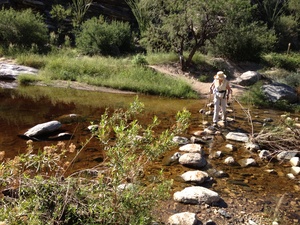 Lower Bear Canyon Photography by: Eric Landwher
Lower Bear Canyon Photography by: Eric Landwher
Activities
Sabino Canyon include their own 45-minute education filled, narrated tour that travels into the foothills of the Santa Catalina Mountains. The tour is a total of 3.8 miles and is given on trams that arrive on average every 30 minutes to an hour throughout the day until 4:00 p.m. The trams have nine stops along the way for visitors to stop and take pictures, as well as use restrooms and other accommodations like water stations and picnic areas. The tram can only take its riders up to stop #9, however, riders are given the opportunity to get off and hike different trails from this point on, or they may ride the tram back down to the Visitor Center. The trams are also used for the Bear Canyon trails. In this case, the tour is non-narrated and takes riders 2 miles up to the trailhead of Seven Falls. Instead of 9 stops, the Bear Canyon tram only includes 3 stop for hikers to select their trail of choice. As long as riders have their tickets, they may get off the tram at any stop and can re-board the tram later on. The tram fares range according to age and whether it's the Sabino Canyon Tour or Bear Canyon Tour.
-
Sabino Canyon Tour Fares
- 13 years & older: $10
- 3-12 years old: $5
- 2 & under: Free
-
Bear Canyon Tour Fares
- 13 years & older: $4
- 3-12 years old: $2
- 2 & under: Free
Aside from taking a guided tour through the Sabino Canyon Recreation Area, the Coronado National Forest offers a wide range of activities. Visitors often partake in activities such as bicycling, camping, fishing, hiking, horse riding, picnicking, scenic driving, water activities, winter sports, and more throughout the forest.
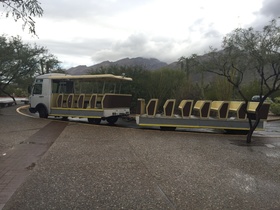 Tram
Tram 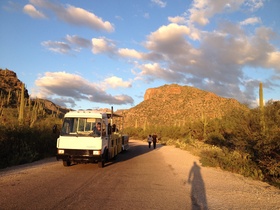 Photography by: Eric Landwher
Photography by: Eric Landwher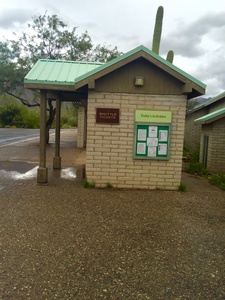 Tram Ticket Office
Tram Ticket Office
Plants and Animals
The Sonoran Desert is filled with a plethora of different plants and animals, and one of the best ways to see these organisms in their natural habitat is by visiting Sabino Canyon. Before Sabino Canyon became a popular recreation center, it was home to some of the most extraordinary creatures. Luckily, with the help of volunteers and the Forest Service the protection of these plants and animals, home remains a top priority. The canyon is considered to be in the lower Sonoran desert, which is considered to be mostly desert shrub. This includes almost every type of cactus ranging from Arizona's state plant, the Saguaro Cactus to Teddy Bear Cholla, which can all be found inside the canyon. In addition many other different shrubs and trees like the Mesquite tree and Palo Verde tree are located in this area. The wild animal population is also quite large. Most commonly visitors will see lizards, prairie dogs, javalinas and coyotes. However, there have been many spotting's of bobcats, rattlesnakes, desert tortoises, and even mountain lions over the past years. These animals are not to be disturbed if seen for the protection of the visitors and the animals.
Often times, visitors will run into hikers, picnickers, or campers with their personal dogs. Dogs are only allowed in areas excluding the Sabino Canyon Recreation Area and the Pusch Ridge Wilderness Sheep Closure Area. The areas that prohibit dogs include Seven Falls, Ventana Canyon Trailhead, Finger Rock Trailhead, Pima Canyon Trailhead, Linda Vista Trailhead, Romero Pools, and Sutherland Trails. If considering bringing a personal dog to any of the trails excluding the ones listed above, remember that dogs must be leashed.
 Saguaro Cactus Photography by: Eric Landwher
Saguaro Cactus Photography by: Eric Landwher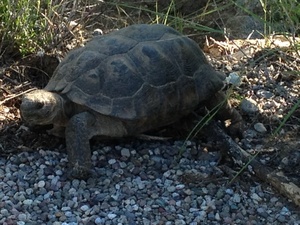 Desert Tortoise Photography by: Eric Landwher
Desert Tortoise Photography by: Eric Landwher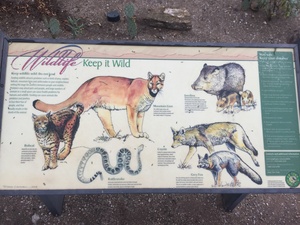
 Collared Lizard Photography by: Eric Landwher
Collared Lizard Photography by: Eric Landwher
Get Involved
Sabino Canyon offers many different opportunities for people in the community to get involved. Some volunteer options include:
- Friends of Sabino Canyon: become a member, donate, or even volunteer with Friends of Sabino Canyon. Their mission is to work to protect, preserve, and enhance Sabino Canyon. For more information check out their website at https://www.sabinocanyon.org/index.htm
- Sabino Canyon Volunteer Naturalists: help lead slow paced hikes throughout the year. For more information call 520-749-8700 for more information on guided walks in nature, hikes, children's programs, activities for the family, and day/field trips for schools.
References
"Sabino Canyon: Our Desert Oasis." Sabino Canyon: Our Desert Oasis. Web. 16 Nov. 2015. <http://parentseyes.arizona.edu/sabino/shistory.html>.
"Sabino Canyon Recreation Center." Coronado National Forest. USDA Forest Service. Web. 16 Nov. 2015. <http://www.fs.usda.gov/recarea/coronado/recarea/?recid=80532>.
"Sabino Canyon Trail - Sabino Canyon Tours at Sabino Canyon, Tucson, Arizona." Sabino Canyon Trail - Sabino Canyon Tours at Sabino Canyon, Tucson, Arizona. Web. 16 Nov. 2015. <http://www.sabinocanyon.com/trail_sc.php>.
Reviews
"Sabino Canyon has some of the best trails for hiking in Tucson, hands down. I visited the area with a few friends on a beautiful day, 70 degree weather, and it was perfect. I can definitely see how the hike can be brutal on a hot day, considering the hike to Seven Falls is an 8-mile hike. It was worth it. Keep in mind that you will be stepping in puddles of water and getting your shoes wet. I would recommend this hike to anyone in the Tucson area." -U of A Student






